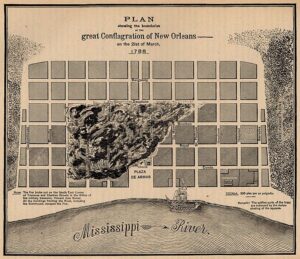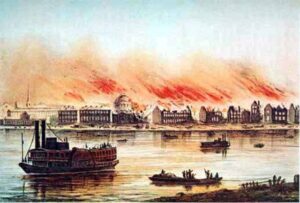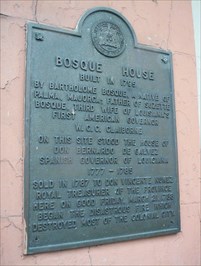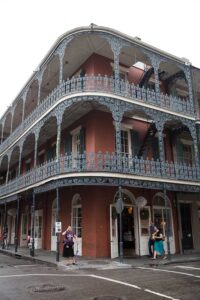
 I don’t know what kind of a city New Orleans was in 1788, but much of it changed that year, because on March 21, 1788, the first of two great fires left the city in ruins. There are a number of ways to destroy a city…time, storms, neglect, need, and the worst one, fire. Were it not for two great fires, there might be more of colonial New Orleans left for people to enjoy. Unfortunately, two great fires in the late eighteenth century left New Orleans and its inhabitants very few years to re-establish their institutions before the onset of American domination in 1803, making the city more American than French. Today, there are several fine houses that date to the last colonial decade, as well as the French Quarter, including the Cabildo and the Presbytere, but they are “post-fire” nevertheless.
I don’t know what kind of a city New Orleans was in 1788, but much of it changed that year, because on March 21, 1788, the first of two great fires left the city in ruins. There are a number of ways to destroy a city…time, storms, neglect, need, and the worst one, fire. Were it not for two great fires, there might be more of colonial New Orleans left for people to enjoy. Unfortunately, two great fires in the late eighteenth century left New Orleans and its inhabitants very few years to re-establish their institutions before the onset of American domination in 1803, making the city more American than French. Today, there are several fine houses that date to the last colonial decade, as well as the French Quarter, including the Cabildo and the Presbytere, but they are “post-fire” nevertheless.
The French Quarter of today is very different from what it once was, and it makes me wonder what it might have been like before. These days, the French Quarter receives millions of visitors annually, and it’s hard to imagine the carnage of the fire of Holy Saturday morning in 1788. The fire was devastating, with smoking ruins stretching from Chartres to Dauphine Street, and from Conti to Saint Philip. The fire actually began on Good Friday morning in the home of Spanish treasurer Don Vincente Nunez at Toulouse and Chartres. The wind was blowing out of the southeast bringing in a blustery cold front. The wind, combined with the fire, reduced over eight hundred homes and public buildings to ashes in a matter of hours. The church, the town hall, and the rectory on the Plaza de Armas were suddenly gone. Governor Esteban Miro told Spanish authorities of the “abject misery, crying, and sobbing” of the people. He wrote that the faces of the families, “told the ruin of a city which in less than five hours has been transformed into an arid and horrible wilderness; the work of seventy years since its foundation.”
The rebuilding of the city began right away, but had barely started when, in 1794 a second fire and two hurricanes swept the city. It seemed that New Orleans was doomed to devastation. The December 8, 1794, fire burned 212 buildings…fewer than the prior fire, but these buildings were more valuable. After the two storms and both fires were done, nearly all the public buildings, homes and businesses, except those fronting the river had been reduced to ashes or badly damaged. Through it all the Ursuline nuns in their convent on Chartres Street had prayed over their hometown, and as the fire got close to the convent on that Good Friday, the wind suddenly shifted. Miraculously, the convent survived and still stands today.
The French Quarter was essentially changed forever. “Baked tile and quarried slate replaced the roofs of ax-hewn cypress shingles. Buildings, set at the sidewalk or banquette, were of all brick, with common firewalls. The wide and shallow hipped roof, galleried townhouse perfected in the French period gave way to vertical, long and narrow Spanish-style town homes, many with overhangs, iron work and entresols or mezzanines. The Cabildo and Presbytere came into being. A new church rose from the ashes. A suburb opened on the upper side of town for residents wary of crowded Quarter conditions. Fire pumps were commissioned. The market moved riverside. Artisans were called in. Protestants gained a foothold. But people went homeless, the city indebted, and lives were lost to death or removal. The city was different.”
Since 1794, the French Quarter has been spared large fires, although there have been some smaller fires, and the hurricanes kept coming. They are just common to the area. A great storm that took place on August 19, 1812, swept away a one-year-old French Market building. Another in 1915 damaged the steeple of Saint Louis Cathedral. A fire in September 1816 took the popular Orleans Theater and Orleans Ballroom. Then, the rebuilt theater burned again in 1866. Fire damaged the Bank of Louisiana on Royal Street resulting in the monumental columns installed in the remodeling, which is now the home of the Vieux Carré Commission.
These devastating losses have resulted in a stringent French Quarter fire code. No longer is the Mardi Gras 
 parade allowed to be motorized. The city takes prevention very seriously, knowing that fire spreading would be devastating to the French Quarter and to the city as a whole. Even with every precaution, the most important fires of the Twentieth Century occurred at individual structures. It is thought, by some historians, that the burning of the Old French Opera House on Bourbon, in 1919, was the “final nail” in the coffin of the old Creole culture in the Quarter, while others adopted that culture, thereby keeping its memory alive. Then, when the Cabildo burned in 1988, two hundred years after the First Great Fire, the citizens of the city felt the loss deeply. The structure was carefully restored, and it stands as a proud reminder of a city’s resolve to safeguard its heritage to this day.
parade allowed to be motorized. The city takes prevention very seriously, knowing that fire spreading would be devastating to the French Quarter and to the city as a whole. Even with every precaution, the most important fires of the Twentieth Century occurred at individual structures. It is thought, by some historians, that the burning of the Old French Opera House on Bourbon, in 1919, was the “final nail” in the coffin of the old Creole culture in the Quarter, while others adopted that culture, thereby keeping its memory alive. Then, when the Cabildo burned in 1988, two hundred years after the First Great Fire, the citizens of the city felt the loss deeply. The structure was carefully restored, and it stands as a proud reminder of a city’s resolve to safeguard its heritage to this day.


Leave a Reply